Epson DS-870 Manual
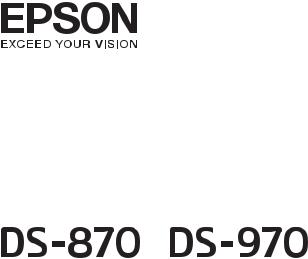
User's Guide
NPD6053-00 EN
User's Guide
Copyright
Copyright
No part of this publication may be reproduced, stored in a retrieval system, or transmitted in any form or by any means, electronic, mechanical, photocopying, recording, or otherwise, without the prior written permission of Seiko Epson Corporation. No patent liability is assumed with respect to the use of the information contained herein. Neither is any liability assumed for damages resulting from the use of the information herein. The information contained herein is designed only for use with this Epson product. Epson is not responsible for any use of this information as applied to other products.
Neither Seiko Epson Corporation nor its affiliates shall be liable to the purchaser of this product or third parties for damages, losses, costs, or expenses incurred by the purchaser or third parties as a result of accident, misuse, or abuse of this product or unauthorized modifications, repairs, or alterations to this product, or (excluding the U.S.) failure to strictly comply with Seiko Epson Corporation's operating and maintenance instructions.
Seiko Epson Corporation and its affiliates shall not be liable for any damages or problems arising from the use of any options or any consumable products other than those designated as Original Epson Products or Epson Approved Products by Seiko Epson Corporation.
Seiko Epson Corporation shall not be held liable for any damage resulting from electromagnetic interference that occurs from the use of any interface cables other than those designated as Epson Approved Products by Seiko Epson Corporation.
© 2018 Seiko Epson Corporation
The contents of this manual and the specifications of this product are subject to change without notice.
2
User's Guide
Trademarks
Trademarks
EPSON®is a registered trademark, and EPSON EXCEED YOUR VISION or EXCEED YOUR VISION is a trademark of the Seiko Epson Corporation.
Microsoft, Windows, Windows Server, and Windows Vista are either registered trademarks or trademarks of Microsoft Corporation in the United States and/or other countries.
Apple, macOS, and OS X are trademarks of Apple Inc., registered in the U.S. and other countries.
Adobe, Adobe Reader, and Acrobat are registered trademarks of Adobe Systems Incorporated.
Intel® is a registered trademark of Intel Corporation.
The SuperSpeed USB Trident Logo is a registered trademark of USB Implementers Forum, Inc.
General Notice: Other product names used herein are for identification purposes only and may be trademarks of their respective owners. Epson disclaims any and all rights in those marks.
3
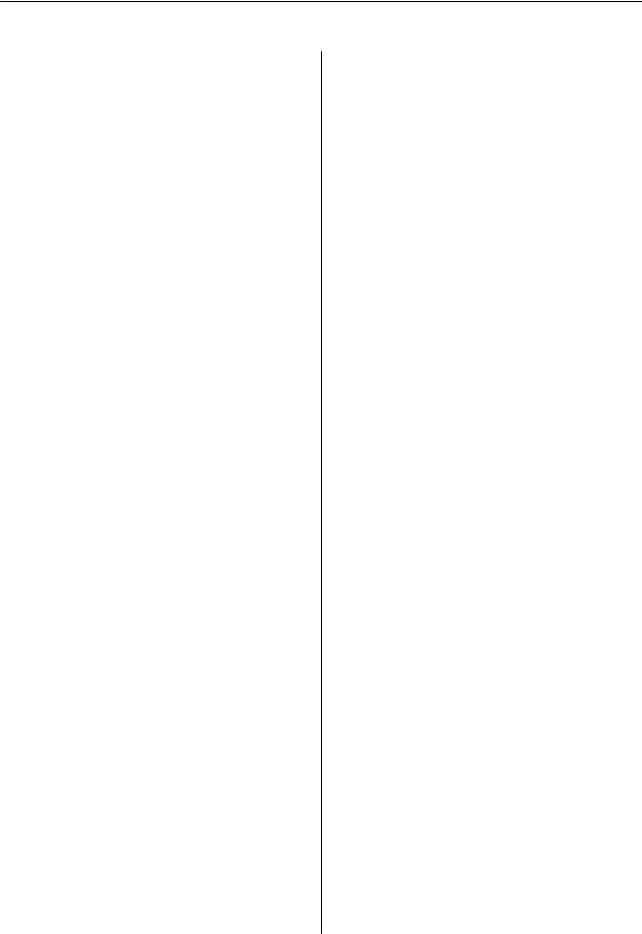
User's Guide
Contents
Contents
Copyright
Trademarks
About This Manual
Introducing the Manuals. . . . . . . . . . . . . . . . . . . . . 7
Marks and Symbols. . . . . . . . . . . . . . . . . . . . . . . . . 7
Descriptions Used in this Manual. . . . . . . . . . . . . . . 7
Operating System References. . . . . . . . . . . . . . . . . . 8
Important Instructions
Safety Instructions. . . . . . . . . . . . . . . . . . . . . . . . . . 9
Restrictions on Copying. . . . . . . . . . . . . . . . . . . . . 10
Scanner Basics
Part Names and Functions. . . . . . . . . . . . . . . . . . . 11
Control Panel. . . . . . . . . . . . . . . . . . . . . . . . . . . . 13
Buttons and Light. . . . . . . . . . . . . . . . . . . . . . . 13 Guide to the LCD Screen. . . . . . . . . . . . . . . . . . 13
Information on Applications. . . . . . . . . . . . . . . . . .17
Epson Scan 2. . . . . . . . . . . . . . . . . . . . . . . . . . . 17 Document Capture Pro / Document Capture. . . .17 Document Capture Pro Server. . . . . . . . . . . . . . 18 EPSON Sof tware Updater. . . . . . . . . . . . . . . . . .18
Option Items and Consumables Information. . . . . . 18
Flatbed Scanner Dock Codes. . . . . . . . . . . . . . . 18
Network Interface Unit Codes. . . . . . . . . . . . . . 19
Carrier Sheet Codes. . . . . . . . . . . . . . . . . . . . . . 19
Roller Assembly Kit Codes. . . . . . . . . . . . . . . . . 20
Cleaning Kit Codes. . . . . . . . . . . . . . . . . . . . . . 20
Specifications of Originals and
Placing Originals
Specif ications of Originals. . . . . . . . . . . . . . . . . . . 21
General Specifications for Originals being Scanned. . . . . . . . . . . . . . . . . . . . . . . . . . . . . . 21 Types of Originals that Require Attention. . . . . . 24 Types of Originals that Must Not be Scanned. . . .25
Placing Originals. . . . . . . . . . . . . . . . . . . . . . . . . . 26
Standard Size Originals. . . . . . . . . . . . . . . . . . . 26
Long Paper. . . . . . . . . . . . . . . . . . . . . . . . . . . . 31
Plastic Cards. . . . . . . . . . . . . . . . . . . . . . . . . . . 33
Laminated Cards. . . . . . . . . . . . . . . . . . . . . . . . 36
Large Size Originals. . . . . . . . . . . . . . . . . . . . . . 39
Irregular Shaped Originals. . . . . . . . . . . . . . . . . 42
Photographs. . . . . . . . . . . . . . . . . . . . . . . . . . . 44
Envelopes. . . . . . . . . . . . . . . . . . . . . . . . . . . . . 47
Mixture of Originals. . . . . . . . . . . . . . . . . . . . . .50
Basic Scanning
Scanning Using the Control Panel. . . . . . . . . . . . . .54
Scanning Using Document Capture Pro
(Windows). . . . . . . . . . . . . . . . . . . . . . . . . . . . . . .56
Scanning Using Document Capture (Mac OS). . . . . 62
Scanning Using Epson Scan 2. . . . . . . . . . . . . . . . . 67
Required Settings for Special Originals in
Epson Scan 2. . . . . . . . . . . . . . . . . . . . . . . . . . . 71 Setting a Resolution That Suits the Scanning Purpose. . . . . . . . . . . . . . . . . . . . . . . . . . . . . . .71
Advanced Scanning
Setting a Job (Scan, Save, and Send). . . . . . . . . . . . 73
Creating and Registering a Job (Windows). . . . . .73 Creating and Registering a Job (Mac OS). . . . . . .74
Enabling a Job to Run from the Control Panel
(Button Assignment). . . . . . . . . . . . . . . . . . . . . . . 74
Assigning a Job to the Control Panel
(Windows). . . . . . . . . . . . . . . . . . . . . . . . . . . . .74 Assigning a Job to the Control Panel (Mac OS). . 75
Scanning Different Sizes or Types of Originals
One by One (Automatic Feeding Mode). . . . . . . . . 75
Separation Feature (for Windows Only). . . . . . . . . .77
Sorting and Saving Scanned Images into a
Separate Folder. . . . . . . . . . . . . . . . . . . . . . . . . 79
Saving as an Office Format File (for Windows
Only). . . . . . . . . . . . . . . . . . . . . . . . . . . . . . . . . . 84
Menu Options on the Control Panel
Scan. . . . . . . . . . . . . . . . . . . . . . . . . . . . . . . . . . . 86
Scanner Settings. . . . . . . . . . . . . . . . . . . . . . . . .86
Edit Job. . . . . . . . . . . . . . . . . . . . . . . . . . . . . . . 87
Scanner Maintenance. . . . . . . . . . . . . . . . . . . . . . . 88
Settings. . . . . . . . . . . . . . . . . . . . . . . . . . . . . . . . . 88
Scanner Settings. . . . . . . . . . . . . . . . . . . . . . . . .88
LCD Brightness. . . . . . . . . . . . . . . . . . . . . . . . . 89
Sleep Timer. . . . . . . . . . . . . . . . . . . . . . . . . . . . 90
Power Of f Timer. . . . . . . . . . . . . . . . . . . . . . . . 90
Language. . . . . . . . . . . . . . . . . . . . . . . . . . . . . .90
4

User's Guide
Contents
Regular Cleaning Alert Settings. . . . . . . . . . . . . 90
System Administration. . . . . . . . . . . . . . . . . . . .90
Device Information. . . . . . . . . . . . . . . . . . . . . . . . 91
Using the Flatbed Scanner Dock
Part Names and Functions of the Flatbed
Scanner Dock. . . . . . . . . . . . . . . . . . . . . . . . . . . . 92
Scanning from the Scanner Glass. . . . . . . . . . . . . . 93
Notes on Using the Flatbed Scanner Dock. . . . . . . . 95
Notes on Scanning from the ADF. . . . . . . . . . . . 95
Maintenance. . . . . . . . . . . . . . . . . . . . . . . . . . . . . 98
Cleaning the Flatbed Scanner Dock. . . . . . . . . . 98
Transferring and Transporting the Flatbed
Scanner Dock. . . . . . . . . . . . . . . . . . . . . . . . . . 99
Troubleshooting for the Flatbed Scanner Dock. . . 100
Uneven Colors, Dirt, Spots, and so on Appear when Scanning from the Scanner Glass. . . . . . . 100 Cannot Scan the Correct Area on the
Scanner Glass. . . . . . . . . . . . . . . . . . . . . . . . . .101 Binding Margins of a Booklet are Distorted
or Blurred. . . . . . . . . . . . . . . . . . . . . . . . . . . . 101 Offset Appears in the Background of Images. . . 101
Maintenance
Cleaning Outside the Scanner. . . . . . . . . . . . . . . . 102
Cleaning Inside the Scanner. . . . . . . . . . . . . . . . . 102
Replacing the Roller Assembly Kit. . . . . . . . . . . . .107
Resetting the Number of Scans. . . . . . . . . . . . . . . 111
Resetting the Number of Scans on the
Control Panel. . . . . . . . . . . . . . . . . . . . . . . . . .112 Resetting the Number of Scans in Epson Scan
2 Utility. . . . . . . . . . . . . . . . . . . . . . . . . . . . . . 112
Energy Saving. . . . . . . . . . . . . . . . . . . . . . . . . . . 113
Transporting the Scanner. . . . . . . . . . . . . . . . . . . 113
Updating Applications and Firmware. . . . . . . . . . 114
Solving Problems
Scanner Problems. . . . . . . . . . . . . . . . . . . . . . . . 116
Checking Messages on the Control Panel. . . . . .116 T he Scanner Does Not Turn On. . . . . . . . . . . . 116
Problems Starting Scanning. . . . . . . . . . . . . . . . . 117
Cannot Start Document Capture Pro
(Windows) or Document Capture (Mac OS). . . 117 Cannot Start Epson Scan 2. . . . . . . . . . . . . . . . 117
Paper Feeding Problems. . . . . . . . . . . . . . . . . . . . 118
Multiple Originals Are Fed. . . . . . . . . . . . . . . . 118 Removing Jammed Originals from the Scanner. 118
The Original Jams in the Scanner Frequently. . . 119 Paper Protection Does not Work Correctly. . . . 120 T he Originals Get Dirty. . . . . . . . . . . . . . . . . . 120 Scanning Speed Slows Down when Scanning Continuously. . . . . . . . . . . . . . . . . . . . . . . . . . 120 Scanning Takes a Long Time. . . . . . . . . . . . . . . 120
Scanned Image Problems. . . . . . . . . . . . . . . . . . . 121
Straight Lines Appear when Scanning from
ADF. . . . . . . . . . . . . . . . . . . . . . . . . . . . . . . . 121 Glass Dirt Alert Does Not Disappear. . . . . . . . .121 Colors Are Uneven in the Scanned Image. . . . . 121 Expanding or Contracting the Scanned Image. . 122 Offset Appears in the Background of Images. . . 122 Scanned Image or Text is Blurred. . . . . . . . . . . 123 Moiré Patterns (Web-Like Shadows) Appear. . . 123 The Edge of the Original is Not Scanned
when Automatically Detecting the Size of the Original. . . . . . . . . . . . . . . . . . . . . . . . . . . . . .124 Character is not Recognized Correctly. . . . . . . .124 Cannot Solve Problems in the Scanned Image. . 124
Uninstalling and Installing Applications. . . . . . . . 125
Uninstalling Your Applications. . . . . . . . . . . . . 125
Installing Your Applications. . . . . . . . . . . . . . . 127
Technical Specifications
General Scanner Specif ications. . . . . . . . . . . . . . . 128
Dimensions and Weight Specif ications. . . . . . . . . 129
Electrical Specif ications. . . . . . . . . . . . . . . . . . . . 129
Scanner Electrical Specifications. . . . . . . . . . . . 129
AC Adapter Electrical Specifications. . . . . . . . . 129
Environmental Specif ications. . . . . . . . . . . . . . . . 130
System Requirements. . . . . . . . . . . . . . . . . . . . . . 130
Standards and Approvals
Standards and Approvals for European Models. . . 132
Standards and Approvals for Australian Models. . . 132
Where to Get Help
Technical Support Web Site. . . . . . . . . . . . . . . . . .133
Contacting Epson Support. . . . . . . . . . . . . . . . . . 133
Before Contacting Epson. . . . . . . . . . . . . . . . . 133 Help for Users in Europe. . . . . . . . . . . . . . . . . .133 Help for Users in Taiwan. . . . . . . . . . . . . . . . . .134 Help for Users in Australia. . . . . . . . . . . . . . . . 134 Help for Users in Singapore. . . . . . . . . . . . . . . 135 Help for Users in T hailand. . . . . . . . . . . . . . . . 135 Help for Users in Vietnam. . . . . . . . . . . . . . . . .135 Help for Users in Indonesia. . . . . . . . . . . . . . . .136
5

User's Guide
Contents
Help for Users in Hong Kong. . . . . . . . . . . . . . 137 Help for Users in Malaysia. . . . . . . . . . . . . . . . 138 Help for Users in India. . . . . . . . . . . . . . . . . . . 138 Help for Users in the Philippines. . . . . . . . . . . . 139
6
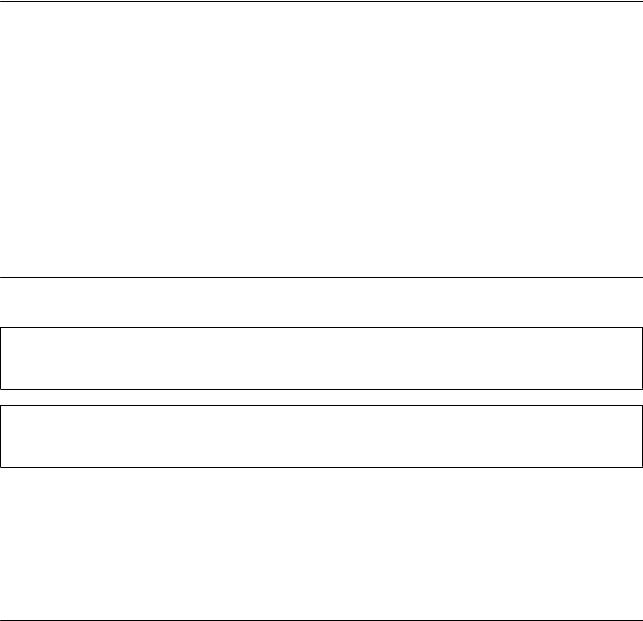
User's Guide
About This Manual
About This Manual
Introducing the Manuals
The latest versions of the following manuals are available from the Epson support website.
http://www.epson.eu/Support (Europe)
http://support.epson.net/ (outside Europe)
Setup Guide (paper manual)
Provides you with information on setting up the product and installing the application.
User's Guide (digital manual)
Provides instructions on using the product, maintenance, and solving problems.
As well as the manuals above, see the help included in the various Epson applications.
Marks and Symbols
!Caution:
Instructions that must be followed carefully to avoid bodily injury.
cImportant:
Instructions that must be observed to avoid damage to your equipment.
Note:
Provides complementary and reference information.
Related Information
& Links to related sections.
Descriptions Used in this Manual
Screenshots for the applications are from Windows 10 or macOS High Sierra. The content displayed on the screens varies depending on the model and situation.
Illustrations used in this manual are for reference only. Although they may differ slightly from the actual product, the operating methods are the same.
7

User's Guide
About This Manual
Operating System References
Windows
In this manual, terms such as "Windows 10", "Windows 8.1", "Windows 8", "Windows 7", "Windows Vista", "Windows XP", "Windows Server 2016", "Windows Server 2012 R2", "Windows Server 2012", "Windows Server 2008 R2", "Windows Server 2008", "Windows Server 2003 R2", and "Windows Server 2003" refer to the following operating systems. Additionally, "Windows" is used to refer to all versions and "Windows Server" is used to refer to "Windows Server 2016", "Windows Server 2012 R2", "Windows Server 2012", "Windows Server 2008 R2", "Windows Server 2008", "Windows Server 2003 R2", and "Windows Server 2003".
Microsoft® Windows® 10 operating system
Microsoft® Windows® 8.1 operating system
Microsoft® Windows® 8 operating system
Microsoft® Windows® 7 operating system
Microsoft® Windows Vista® operating system
Microsoft® Windows® XP operating system Service Pack 3
Microsoft® Windows® XP Professional x64 Edition operating system Service Pack 2
Microsoft® Windows Server®2016 operating system
Microsoft® Windows Server®2012 R2 operating system
Microsoft® Windows Server®2012 operating system
Microsoft® Windows Server®2008 R2 operating system
Microsoft® Windows Server®2008 operating system
Microsoft® Windows Server®2003 R2 operating system
Microsoft® Windows Server®2003 operating system Service Pack 2
Mac OS
In this manual, "Mac OS" is used to refer to macOS High Sierra, macOS Sierra, OS X El Capitan, OS X Yosemite, OS X Mavericks, OS X Mountain Lion, Mac OS X v10.7.x, and Mac OS X v10.6.8.
8

User's Guide
Important Instructions
Important Instructions
Safety Instructions
Read and follow these instructions to ensure safe use of this product and options. Make sure you keep this manual for future reference. Also, be sure to follow all warnings and instructions marked on the product and options.
Some of the symbols used on your product and options are to ensure safety and proper use of the product. Visit the following Web site to learn the meaning of the symbols.
http://support.epson.net/symbols
Place the product and options on a flat, stable surface that extends beyond the base of the product and options in all directions. If you place the product and options by the wall, leave more than 10 cm between the back of the product and options and the wall.
Place the product and options close enough to the computer for the interface cable to reach it easily. Do not place or store the product and options or the AC adapter outdoors, near excessive dirt or dust, water, heat sources, or in locations subject to shocks, vibrations, high temperature or humidity, direct sunlight, strong light sources, or rapid changes in temperature or humidity.
Do not use with wet hands.
Place the product and options near an electrical outlet where the adapter can be easily unplugged.
The AC adapter cord should be placed to avoid abrasions, cuts, fraying, crimping, and kinking. Do not place objects on top of the cord and do not allow the AC adapter or the cord to be stepped on or run over. Be particularly careful to keep the cord straight at the end.
Use only the power cord supplied with the product and do not use the cord with any other equipment. Use of other cords with this product or the use of the supplied power cord with other equipment may result in fire or electric shock.
Use only the AC adapter that comes with your product. Using any other adapter could cause fire, electrical shock, or injury.
The AC adapter is designed for use with the product with which it was included. Do not attempt to use it with other electronic devices unless specified.
Use only the type of power source indicated on the AC adapter’s label, and always supply power directly from a standard domestic electrical outlet with the AC adapter that meets the relevant local safety standards.
When connecting this product and options to a computer or other device with a cable, ensure the correct orientation of the connectors. Each connector has only one correct orientation. Inserting a connector in the wrong orientation may damage both devices connected by the cable.
Avoid using outlets on the same circuit as photocopiers or air control systems that regularly switch on and off.
If you use an extension cord with the product, make sure the total ampere rating of the devices plugged into the extension cord does not exceed the cord’s ampere rating. Also, make sure the total ampere rating of all devices plugged into the wall outlet does not exceed the wall outlet’s ampere rating.
Never disassemble, modify, or attempt to repair the AC adapter, product, or product options by yourself except as specifically explained in the product’s guides.
Do not insert objects into any opening as they may touch dangerous voltage points or short out parts. Beware of electrical shock hazards.
If damage occurs to the plug, replace the cord set or consult a qualified electrician. If there are fuses in the plug, make sure you replace them with fuses of the correct size and rating.
9

User's Guide
Important Instructions
Unplug the product, options, and the AC adapter, and refer servicing to qualified service personnel under the following conditions: The AC adapter or plug is damaged; liquid has entered the product, options, or the AC adapter; the product or the AC adapter has been dropped or the case has been damaged; the product, options, or the AC adapter does not operate normally or exhibits a distinct change in performance. (Do not adjust controls that are not covered by the operating instructions.)
Unplug the product and the AC adapter before cleaning. Clean with a damp cloth only. Do not use liquid or aerosol cleaners except as specifically explained in the product’s guides.
If you are not going to use the product for a long period, be sure to unplug the AC adapter from the electrical outlet.
After replacing consumable parts, dispose of them correctly following the rules of your local authority. Do not disassemble them.
If the LCD screen is damaged, contact your dealer. If the liquid crystal solution gets on your hands, wash them thoroughly with soap and water. If the liquid crystal solution gets into your eyes, flush them immediately with water. If discomfort or vision problems remain after a thorough flushing, see a doctor immediately.
Restrictions on Copying
Observe the following restrictions to ensure the responsible and legal use of your product.
Copying of the following items is prohibited by law:
Bank bills, coins, government-issued marketable securities, government bond securities, and municipal securities
Unused postage stamps, pre-stamped postcards, and other official postal items bearing valid postage
Government-issued revenue stamps, and securities issued according to legal procedure
Exercise caution when copying the following items:
Private marketable securities (stock certificates, negotiable notes, checks, etc.), monthly passes, concession tickets, etc.
Passports, driver’s licenses, warrants of fitness, road passes, food stamps, tickets, etc.
Note:
Copying these items may also be prohibited by law.
Responsible use of copyrighted materials:
Products can be misused by improperly copying copyrighted materials. Unless acting on the advice of a knowledgeable attorney, be responsible and respectful by obtaining the permission of the copyright holder before copying published material.
10
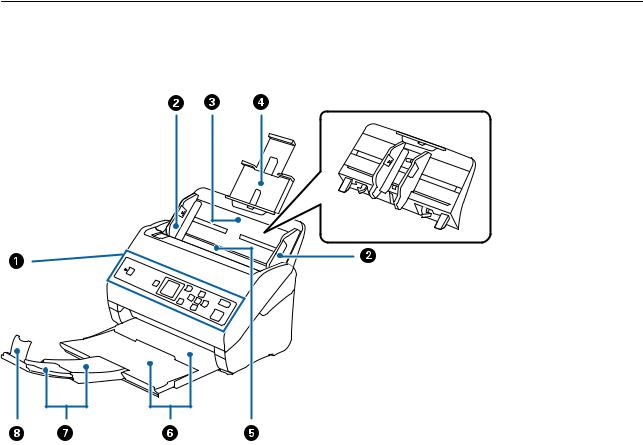
User's Guide
Scanner Basics
Scanner Basics
Part Names and Functions
Front
A |
Control panel |
Indicates the scanner’s status and allows you to make scanning |
|
|
|
settings. |
|
|
|
|
|
B |
Edge guides |
Feeds originals straight into the scanner. Slide to the edges of the |
|
|
|
originals. |
|
|
|
|
|
C |
Input tray |
Loads originals. Pull out the tray extension if originals are too big |
|
|
|
for the input tray. This prevents paper from curling and causing |
|
|
Input tray extension |
||
D |
paper jams. |
||
|
|
When removing the input tray, slide the hooks that are on both |
|
|
|
ends at the back, and then pull out the input tray. |
|
|
|
|
|
E |
ADF (Automatic Document Feeder) |
Feeds loaded originals automatically. |
|
|
|
|
|
F |
Output tray |
Holds originals ejected from the scanner. Pull out the extension |
|
|
|
tray to the length of the originals. |
|
G |
Output tray extension |
||
|
|||
|
|
|
|
H |
Stopper |
Prevents ejected originals from falling off the extension tray. Adjust |
|
|
|
it to the length of the originals. |
|
|
|
|
11
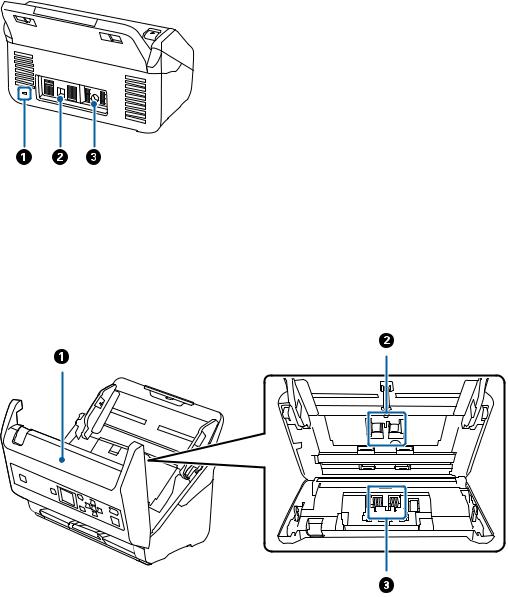
User's Guide
Scanner Basics
Back
A |
Security slot |
Inserts a security lock for theft prevention. |
|
|
|
B |
USB port |
Connects a USB cable. |
|
|
|
C |
DC inlet |
Connects the AC adapter. |
|
|
|
Inside
A |
Scanner cover |
Pull the lever and open the scanner cover when cleaning inside the |
|
|
scanner and removing jammed paper. |
|
|
|
B |
Pickup roller |
Feeds originals. This needs to be replaced when the number of |
|
|
scans exceeds the service number of papers. |
|
|
|
C |
Separation roller |
Feeds originals separately one by one. This needs to be replaced |
|
|
when the number of scans exceeds the service number of papers. |
|
|
|
Related Information
&“Cleaning Inside the Scanner” on page 102
&“Replacing the Roller Assembly Kit” on page 107
12
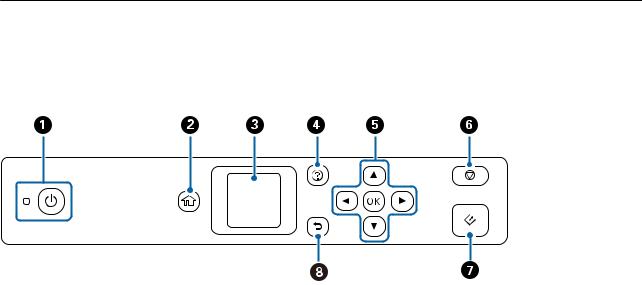
User's Guide
Scanner Basics
Control Panel
Buttons and Light
A |
Turns the scanner on or off. |
|
Do not turn off the scanner while the light is flashing because the scanner is operating or processing a job. |
|
|
B |
Displays the home screen. |
|
|
C |
Displays menus and messages. |
|
|
D |
Displays the help screen. |
|
You can check how to solve problems and how to load originals. |
|
|
E |
Use the u d l r buttons to highlight an item, and then press the OK button to open the selected menu |
|
or to make settings. |
|
|
F |
Cancels scanning or the current operation. |
|
Exits Automatic Feeding Mode. |
|
Clears setting changes on the Edit Job screen. |
|
|
G |
Starts scanning. |
|
Press this when cleaning the inside of the scanner. |
|
|
H |
Returns to the previous screen. |
|
|
Guide to the LCD Screen
Menus and messages are displayed on the LCD screen. Select a menu or setting by pressing the u d l r buttons.
13
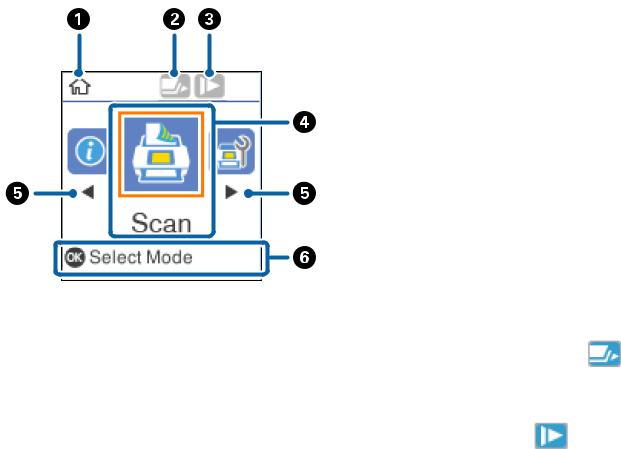
User's Guide
Scanner Basics
Guide to the Home Screen
The following icons and menus are displayed on the home screen.
A |
This icon indicates that you are on the home screen. |
|
|
|
|
|
|
|
|
B |
|
|
|
|
|
This icon indicates whether or not the DFDS Function feature is enabled. When enabled, the icon changes to |
. |
||
|
This feature skips double feed detection once and continues scanning. Enable this to scan originals that are detected as |
|||
|
double feeds, for example plastic cards or envelopes. |
|
|
|
|
|
|
|
|
C |
|
|
|
|
|
This icon indicates whether or not the Slow feature is enabled. When enabled, the icon changes to |
. |
|
|
|
This feature slows down the scanning speed. Enable this to scan originals that are likely to jam, for example thin paper. |
|||
|
|
|
|
|
D |
Function icons and names are displayed as menu icons. |
|
|
|
|
|
|
|
|
|
Scan |
Enters the Scan menu. |
|
|
|
|
You can scan using jobs on your computer that were created in Document Capture Pro |
|
|
|
|
(Windows)/Document Capture (Mac OS). |
|
|
|
|
|
|
|
|
Scanner |
Enters the Scanner Maintenance menu. |
|
|
|
Maintenance |
Displays information on how to maintain the scanner. |
|
|
|
|
|
|
|
|
|
|
|
|
|
Settings |
Enters the Settings menu. |
|
|
|
|
You can change the settings of the scanner. |
|
|
|
|
|
|
|
|
Device Information |
Enters the Device Information menu. |
|
|
|
|
Displays information for the scanner. |
|
|
|
|
|
|
|
E |
When l and r are displayed, you can use them to scroll right or left. |
|
|
|
|
|
|
|
|
F |
Displays available buttons. |
|
|
|
|
In this example, you can go to the selected menu by pressing the OK button. |
|
|
|
|
|
|
|
|
14
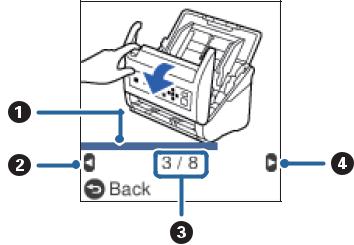
User's Guide
Scanner Basics
Related Information
&“Scanning Using the Control Panel” on page 54
&“Menu Options on the Control Panel” on page 86
&“Replacing the Roller Assembly Kit” on page 107
Viewing Guidance Animations
You can watch animated guides that explain how to maintain the scanner, replace the rollers, place various kind of originals, and so on.
Press the  button on the scanner to display the help screen. Select How To, and then select the items that you want to view.
button on the scanner to display the help screen. Select How To, and then select the items that you want to view.
Press the OK button when How To appears at the bottom of the operation screen to display context-sensitive animations.
A |
Indicates your progress through the current step. The animation repeats when the progress bar reaches the end. |
|
|
B |
Press the l button to return to the previous step. |
|
|
C |
Indicates the total number of steps and the current step number. |
|
The example above shows step 3 of 8. |
|
|
D |
Press the r button to go to the next step. |
|
|
Restricting User Access for the Control Panel
You can restrict user access for settings on the control panel by using Restrict User Access.
Note:
If the scanner has an administrator, contact your administrator before enabling Restrict User Access.
1.Select Settings from the home screen using the l or r button, and then press the OK button.
2.Select System Administration using the l or r button, and then press the OK button.
15
User's Guide
Scanner Basics
3.Select Restrict User Access using the l or r button, and then press the OK button.
4.Select On using the d or u button, and then press the OK button.
5.When the message To enable Restrict User Access, see your documentation. is displayed, hold down the u and d buttons simultaneously for more than one second.
After Restrict User Access is set, you are returned to the Settings screen.
6.Next, check that the Restrict User Access is set correctly. Press the OK button on the System Administration menu.
7.If the message Restrict User Access is enabled. For more details, see your documentation. is displayed,
Restrict User Access is set correctly.
Accessing Restricted Settings on the Control Panel
If Restrict User Access is enabled, you can access the settings by using a special key operation.
Note:
If the scanner has an administrator, contact your administrator before accessing restricted settings.
1.When the message Restrict User Access is enabled. For more details, see your documentation. is displayed, hold down the u and d buttons simultaneously for more than one second.
The setting screen for the selected menu is displayed, and you can edit the settings.
2.Make the settings, and then press the OK button.
Disable User Access Restriction for the Control Panel
Follow the steps below to disable Restrict User Access.
Note:
If the scanner has an administrator, contact your administrator before disabling Restrict User Access.
1.Select Settings on the home screen using the l or r button, and then press the OK button.
2.Select System Administration using the l or r button, and then press the OK button.
3.When the message Restrict User Access is enabled. For more details, see your documentation. is displayed, hold down the u and d buttons simultaneously for more than one second.
The System Administration screen is displayed, and you can edit the settings.
4.Select Restrict User Access using the l or r button, and then press the OK button.
5.Select Off using the u or d button, and then press the OK button.
Setting Menus that can be Restricted
You can restrict user access for the following menus by enabling Restrict User Access.
16

User's Guide
Scanner Basics
Device Information
Number of Scans After Replacing Roller
Number of Scans After Regular Cleaning
Settings
Scanner Settings
·Paper Protection
·Detect Glass Dirt
·Ultrasonic Double Feed Detection
Sleep Timer
Power Off Timer
Language
Regular Cleaning Alert Settings
System Administration
Information on Applications
This section introduces the application products available for your scanner. The latest application can be installed at the Epson Web site.
Epson Scan 2
Epson Scan 2 is a driver for controlling your scanner, enabling a variety of scan settings. This also allows you to start either as a standalone application or by using TWAIN-compliant application software.
See the Epson Scan 2 help for details on using the application.
Document Capture Pro / Document Capture
Document Capture Pro is an application that allows you to easily digitize originals such as documents and forms.
You can save scanned images to a specified folder, send by email, and perform copying functions by linking to a printer. You can also split documents by using separation information such as barcodes and automatically process new files. This allows you to streamline the way electronic documents are handled, such as reading large documents and making best use of network capabilities.
Document Capture Pro is for Windows only. For Mac OS, use Document Capture, and for Windows Server, use Document Capture Pro Server.
See the Document Capture Pro help (Windows) or Document Capture (Mac OS) for details on using the application.
Note:
Document Capture Pro does not support Windows Vista/Windows XP.
Job:
When performed in order, the following operations are known as a job: 1. Scan > 2. Save > 3. Send.
17

User's Guide
Scanner Basics
By registering a series of operations in advance as a job, you can perform all of the operations by simply selecting the job. By assigning a job to the scanner’s control panel, you can start a job from the control panel (Button Assignment).
Separation Function:
You can automatically process complicated sorting or organizing by using a variety of detection methods such as blank pages with/without barcodes which are inserted between the originals, or barcodes on the originals.
You can also sort multiple scanned images as separate files and save each file in specific folders by using these methods or by setting specific pages.
Document Capture Pro Server
Document Capture Pro Server is an application for Windows Server that allows you to manage up to 100 scanners on the network through servers.
By using a web browser, you can register and monitor scanners or register jobs: 1. Scan > 2. Save > 3. Send and assign them to individual scanners. You can scan by simply selecting a job on a scanner managed by Document Capture Pro Server.
For further information, contact your local Epson office.
Note:
The optional Network Interface Unit is required to use this application.
EPSON Software Updater
EPSON Software Updater is an application that checks for new or updated applications on the internet and installs them.
You can also update the scanner’s digital manual.
Note:
Windows Server operating systems are not supported.
Option Items and Consumables Information
Flatbed Scanner Dock Codes
The dock combines the product (the sheet feed scanner) and a flatbed scanner allowing you to use it as a single scanner. This allows you to scan cardboard, booklets, and so on, that you cannot feed using the ADF.
Note:
You cannot use the Network Interface Unit and the Flatbed Scanner Dock at the same time.
Part name |
Codes |
|
|
Flatbed Scanner Dock * |
B12B819011 |
|
B12B819021 (China only) |
|
|
Flatbed Scanner |
Epson Perfection V19/V39 |
|
|
18
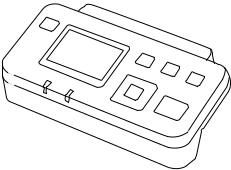
User's Guide
Scanner Basics
*Windows only
Network Interface Unit Codes
You can scan through a network by using Document Capture Pro (Windows only). By registering frequently used scan process settings such as save, sort, transfer, and so on, with a name such as "job", you can reduce the workload and increase efficiency by simply selecting “job” on the control panel. See the manual for more details.
Note:
You cannot use the Network Interface Unit and the Flatbed Scanner Dock at the same time.
Part name |
Codes *2 |
Specifications |
Network Interface Unit *1 |
B12B808451 (European, Middle East, |
Available for 1000BASE-T/100BASE-TX/ |
|
and African countries) |
10BASE-T, IPv6, IEEE802.3az |
|
B12B808461 (Asia Pacific countries |
|
|
excluding China and Korea) |
|
|
B12B808464 (China) |
|
|
B12B808466 (Korea) |
|
|
|
|
*1 When mounted, you cannot use the scanner or a computer over a USB connection.
*2 Codes may vary by region.
Carrier Sheet Codes
Using a Carrier Sheet allows you to scan irregular shaped originals or photos that can be easily scratched. You can scan originals larger than A4 size with a carrier sheet by folding it in half.
Part name |
Codes* |
Carrier Sheet |
B12B819051 |
|
|
*You can only use the carrier sheet with the code.
Related Information
&“General Specifications for Originals being Scanned” on page 21
&“Placing Large Size Originals” on page 39
&“Placing Irregular Shaped Originals” on page 42
19
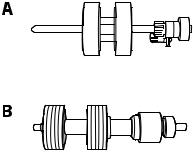
User's Guide
Scanner Basics
& “Placing Photographs” on page 45
Roller Assembly Kit Codes
Parts (the pickup roller and separation roller) should be replaced when the number of scans exceeds the service number. You can check the latest number of scans on the control panel or in the Epson Scan 2 Utility.
A: pickup roller, B: separation roller
Part name |
Codes |
Life cycle |
|
|
|
Roller Assembly Kit |
B12B819031 |
200,000* |
|
B12B819041 (China only) |
|
|
|
|
* This number was reached by consecutively scanning using Epson test original papers, and is a guide to the replacement cycle. The replacement cycle may vary depending on different paper types, such as paper that generates a lot of paper dust or paper with a rough surface that may shorten the life cycle.
Related Information
&“Replacing the Roller Assembly Kit” on page 107
&“Resetting the Number of Scans on the Control Panel” on page 112
Cleaning Kit Codes
Use this when cleaning inside the scanner. This kit is composed of cleaning liquid and a cleaning cloth.
Part name |
Codes |
|
|
Cleaning Kit |
B12B819291 |
|
|
Related Information
& “Cleaning Inside the Scanner” on page 102
20
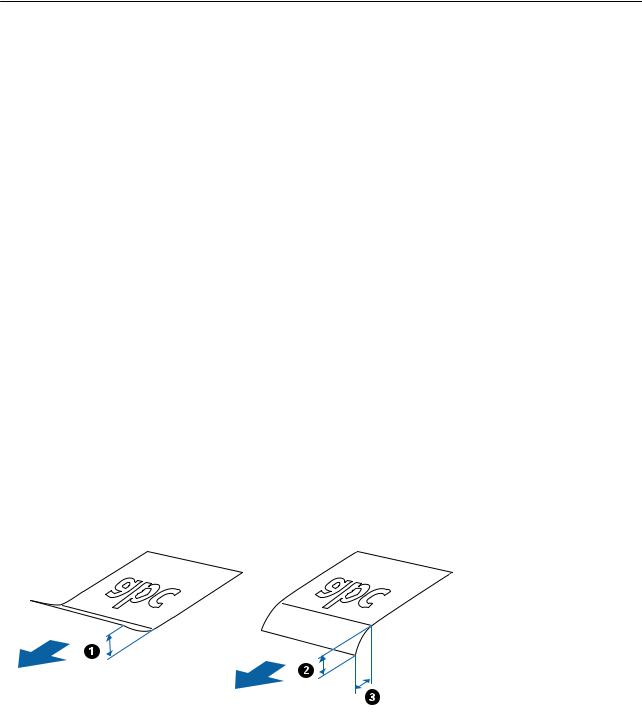
User's Guide
Specifications of Originals and Placing Originals
Specifications of Originals and Placing
Originals
Specifications of Originals
This section explains the specifications and conditions of originals that can be loaded in the ADF.
General Specifications for Originals being Scanned
Type of Original |
Thickness |
Size |
|
|
|
Plain paper |
27 to 413 g/m2 |
Maximum: 215.9×6,096.0 mm |
Fine paper |
A8 size or less: 127 to 413 g/m2 |
(8.5×240.0 in.) |
|
||
Recycled paper |
Plastic cards: 1.24 mm (0.05 in.) or less |
Minimum: 50.8×50.8 mm (2.0×2.0 in.) |
|
||
Post card |
(including emboss) |
The loadable size varies depending on |
|
the type of originals. |
|
|
Laminated Cards: 0.8 mm (0.03 in.) or |
|
Business card |
|
|
less |
|
|
|
|
|
Envelopes |
|
|
Plastic cards complying with ISO7810 |
|
|
ID-1 type (with or without emboss) |
|
|
Laminated cards |
|
|
Thermal paper |
|
|
|
|
|
Note:
All originals must be flat at the leading edge.
Make sure that curls on the leading edge of the originals are kept within the following range.
A must be 3 mm or less.
B must be 1 mm or less while B is equal to or less than C. When C is equal to or more than 10 times the size of B, B can be more than 1 mm.
Even when the original meets the specifications for originals that can be placed in the ADF, it may not feed from the ADF or the scan quality may decline depending on the paper properties or quality.
21
User's Guide
Specifications of Originals and Placing Originals
Specifications of Standard Size Originals
The list of the standard size originals you can load on the scanner.
Size |
Measurement |
Thickness |
Paper Type |
Loading Capacity * |
Legal |
215.9×355.6 mm |
27 to 413 g/m2 |
Plain paper |
Thickness of the originals stack: |
|
(8.5×14 in.) |
|
Fine paper |
under 12 mm (0.47 in.) |
|
|
|
||
|
|
|
Recycled paper |
80 g/m2: 80 sheets |
|
|
|
|
|
|
|
|
|
90 g/m2: 69 sheets |
|
|
|
|
104 g/m2: 59 sheets |
|
|
|
|
127 g/m2: 50 sheets |
|
|
|
|
157 g/m2: 40 sheets |
|
|
|
|
209 g/m2: 30 sheets |
|
|
|
|
256 g/m2: 24 sheets |
|
|
|
|
413 g/m2: 14 sheets |
|
|
|
|
The loading capacity varies |
|
|
|
|
depending on the paper type. |
|
|
|
|
|
Letter |
215.9×279.4 mm |
|
|
Thickness of the originals stack: |
|
(8.5×11 in.) |
|
|
under 12 mm (0.47 in.) |
|
|
|
|
|
|
|
|
|
80 g/m2: 100 sheets |
A4 |
210×297 mm |
|
|
|
|
|
90 g/m2: 86 sheets |
||
|
(8.3×11.7 in.) |
|
|
|
|
|
|
104 g/m2: 74 sheets |
|
|
|
|
|
|
B5 |
182×257 mm |
|
|
|
|
|
127 g/m2: 62 sheets |
||
|
(7.2×10.1 in.) |
|
|
157 g/m2: 50 sheets |
|
|
|
|
209 g/m2: 38 sheets |
A5 |
148×210 mm |
|
|
|
|
(5.8×8.3 in.) |
|
|
256 g/m2: 30 sheets |
|
|
|
|
413 g/m2: 18 sheets |
B6 |
128×182 mm |
|
|
|
|
|
|
||
|
(5.0×7.2 in.) |
|
|
The loading capacity varies |
|
|
|
depending on the paper type. |
|
|
|
|
|
|
A6 |
105×148 mm |
|
|
|
|
(4.1×5.8 in.) |
|
|
|
|
|
|
|
|
A8 |
52×74 mm |
127 to 413 g/m2 |
|
|
|
(2.1×2.9 in.) |
|
|
|
|
|
|
|
|
Business Card |
55×89 mm |
210 g/m2 |
|
Thickness of the originals stack: |
|
(2.1×3.4 in.) |
|
|
under 12 mm (0.47 in.) |
|
|
|
|
|
|
|
|
|
30 sheets |
|
|
|
|
|
*You can refill the originals up to the maximum capacity during scanning.
Specifications of Long Paper
The specification of long paper you can load into the scanner.
22
User's Guide
Specifications of Originals and Placing Originals
Size |
Thickness |
Paper Type |
Loading Capacity |
|
|
|
|
Width: 50.8 to 215.9 mm |
50 to 130 g/m2 |
Plain paper |
1 sheet |
(2.0 to 8.5 in.) |
|
Fine paper |
|
Length: 393.8 to 6,096.0 mm |
|
Recycled paper |
|
(15.5 to 240.0 in.) |
|
|
|
|
|
|
|
Specifications of Plastic Cards
The specification of plastic card you can load into the scanner.
Size |
Card Type |
Thickness |
Loading Capacity |
Loading Direction |
|
|
|
|
|
ISO7810 ID-1 Type |
With embossing |
1.24 mm (0.05 in.) or |
1 card |
Horizontal (Landscape) |
54.0×85.6 mm |
|
less |
|
|
|
|
|
|
|
(2.1×3.3 in.) |
Without embossing |
1.1 mm (0.04 in.) or |
5 cards |
|
|
|
less |
|
|
|
|
|
|
|
Specifications of Laminated Cards
The specification of laminated cards you can load into the scanner.
Size |
Thickness |
Loading Capacity |
|
|
|
120.0×150.0 mm (4.7×5.9 in.) or less |
0.8 mm (0.03 in.) or less |
1 card |
|
|
|
Specifications for Originals Using the Carrier Sheet
The optional Carrier Sheet is a sheet designed to transport originals through the scanner. You can scan originals that are larger than A4/Letter size, important documents or photos which must not damaged, thin paper, irregular shaped originals, and so on.
The following table provides the conditions for using the Carrier Sheet.
23
User's Guide
Specifications of Originals and Placing Originals
Type |
Size |
Thickness |
Loading Capacity of |
|
|
|
the Carrier Sheet |
|
|
|
|
Originals that cannot be |
A3*1 |
0.3 mm (0.012 in.) or less |
10 sheets |
loaded directly into the |
A4 |
(excluding the thickness of |
|
scanner |
|
||
|
the Carrier Sheet) |
|
|
|
B4*1 |
|
|
|
|
|
|
|
Letter |
|
|
|
Legal*1 |
|
|
|
B5 |
|
|
|
A5 |
|
|
|
B6 |
|
|
|
A6 |
|
|
|
A8 |
|
|
|
Custom size: |
|
|
|
Width: up to 431.8 mm (17 in.) *2 |
|
|
|
Length: up to 297 mm (11.7 in.) *3 |
|
|
*1 Fold in half to set.
*2 Originals that are wider than 215.9 mm (8.5 in.) need to be folded in half.
*3 The leading edge of the original must be placed at the binding part of the Carrier Sheet when scanning an original approximately 297 mm (11.7 in.) long. Otherwise, the length of the scanned image may be longer than intended as the scanner scans to the end of the Carrier Sheet when you select Auto Detect as the Document Size setting in the application.
Related Information
& “Carrier Sheet Codes” on page 19
Specifications of Envelopes
The specification of envelopes you can load into the scanner.
Size |
Measurement |
Thickness |
Loading Capacity |
|
|
|
|
C6 |
114×162 mm (4.49×6.38 in.) |
0.38 mm (0.015 in.) or less |
10 envelopes |
|
(standard size) |
|
|
|
|
|
|
DL |
110×220 mm (4.33×8.66 in.) |
|
|
|
(standard size) |
|
|
|
|
|
|
Types of Originals that Require Attention
The following types of originals may not be successfully scanned.
Originals with an uneven surface such as letter head paper.
Originals with crinkles or fold lines
24

User's Guide
Specifications of Originals and Placing Originals
Perforated originals
Original with labels or stickers
Carbon-less paper
Curled originals
Coated paper
cImportant:
Carbon-less paper contains chemical substances that may harm the rollers. If you scan carbon-less paper, clean the pickup roller and the separation roller regularly. Also, scanning carbon-less paper may shorten the life cycle of the rollers faster than scanning plain paper.
Note:
Crinkled originals may scan better if you slow down the feeding speed during scanning or smooth out the crinkles before loading.
To scan delicate originals or originals that are easily crinkled, use the Carrier Sheet (sold separately).
To scan originals that are incorrectly detected as double feeds, set the DFDS Function to On on the control panel before you resume scanning, or select Off in Detect Double Feed on the Main Settings tab in the Epson Scan 2 window. When you are using Document Capture Pro, you can open the window by pressing the Detailed Settings button on the Scan Settings screen.
Labels or stickers must be firmly stuck to the originals with no glue protruding.
Try to flatten the curled originals before scanning.
Related Information
&“Scanner Basics” on page 11
&“Maintenance” on page 102
Types of Originals that Must Not be Scanned
The following types of originals must not be scanned.
Photos
Booklets
Non-paper original (such as clear files, fabric, and metal foil)
Originals with staples or paper clips
Originals with glue attached
Ripped originals
Heavily wrinkled or curled originals
Transparent originals such as OHP film
Originals with carbon paper on the back
Originals with wet ink
Originals with sticky notes attached
25

User's Guide
Specifications of Originals and Placing Originals
Note:
Do not feed photos, valuable original artwork, or important documents which you do not want to damage or deface into the scanner directly. Misfeeding may wrinkle or damage the original. When scanning such originals, make sure you use the Carrier Sheet (sold separately).
Rippled, wrinkled, or curled originals can also be scanned if you use the Carrier Sheet (sold separately).
Related Information
& “Photographs” on page 44
Placing Originals
Standard Size Originals
Specifications of Standard Size Originals
The list of the standard size originals you can load on the scanner.
26
User's Guide
Specifications of Originals and Placing Originals
Size |
Measurement |
Thickness |
Paper Type |
Loading Capacity * |
Legal |
215.9×355.6 mm |
27 to 413 g/m2 |
Plain paper |
Thickness of the originals stack: |
|
(8.5×14 in.) |
|
Fine paper |
under 12 mm (0.47 in.) |
|
|
|
||
|
|
|
Recycled paper |
80 g/m2: 80 sheets |
|
|
|
|
|
|
|
|
|
90 g/m2: 69 sheets |
|
|
|
|
104 g/m2: 59 sheets |
|
|
|
|
127 g/m2: 50 sheets |
|
|
|
|
157 g/m2: 40 sheets |
|
|
|
|
209 g/m2: 30 sheets |
|
|
|
|
256 g/m2: 24 sheets |
|
|
|
|
413 g/m2: 14 sheets |
|
|
|
|
The loading capacity varies |
|
|
|
|
depending on the paper type. |
|
|
|
|
|
Letter |
215.9×279.4 mm |
|
|
Thickness of the originals stack: |
|
(8.5×11 in.) |
|
|
under 12 mm (0.47 in.) |
|
|
|
|
|
|
|
|
|
80 g/m2: 100 sheets |
A4 |
210×297 mm |
|
|
|
|
|
90 g/m2: 86 sheets |
||
|
(8.3×11.7 in.) |
|
|
|
|
|
|
104 g/m2: 74 sheets |
|
|
|
|
|
|
B5 |
182×257 mm |
|
|
|
|
|
127 g/m2: 62 sheets |
||
|
(7.2×10.1 in.) |
|
|
157 g/m2: 50 sheets |
|
|
|
|
209 g/m2: 38 sheets |
A5 |
148×210 mm |
|
|
|
|
(5.8×8.3 in.) |
|
|
256 g/m2: 30 sheets |
|
|
|
|
413 g/m2: 18 sheets |
B6 |
128×182 mm |
|
|
|
|
|
|
||
|
(5.0×7.2 in.) |
|
|
The loading capacity varies |
|
|
|
depending on the paper type. |
|
|
|
|
|
|
A6 |
105×148 mm |
|
|
|
|
(4.1×5.8 in.) |
|
|
|
|
|
|
|
|
A8 |
52×74 mm |
127 to 413 g/m2 |
|
|
|
(2.1×2.9 in.) |
|
|
|
|
|
|
|
|
Business Card |
55×89 mm |
210 g/m2 |
|
Thickness of the originals stack: |
|
(2.1×3.4 in.) |
|
|
under 12 mm (0.47 in.) |
|
|
|
|
|
|
|
|
|
30 sheets |
|
|
|
|
|
*You can refill the originals up to the maximum capacity during scanning.
27
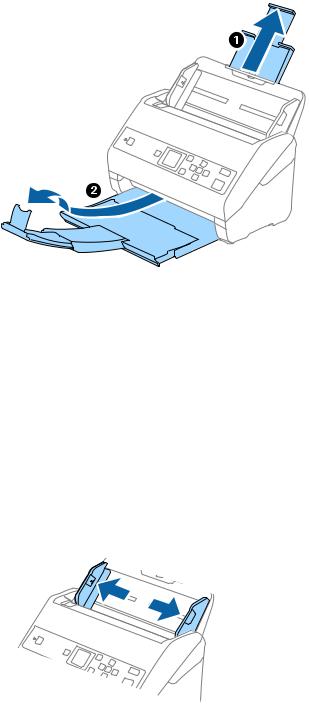
User's Guide
Specifications of Originals and Placing Originals
Placing Standard Size Originals
1.Extend the input tray extension. Slide out the output tray, extend the output tray extension, and then raise the stopper.
Note:
For A4 size or larger originals, make sure you pull out and extend the input tray extension.
Make sure you pull out and extend the output tray extensions so that they are a little bit longer than the length of the original, and raise the stopper so that the ejected originals can be stacked comfortably on the output tray.
The stopper can move forward and backward on the output tray extension so that you can easily adjust the stopper position to the best position for the originals being scanned.
If thick originals bump into the output tray and fall from it, store the output tray and do not use it to stack the ejected originals.
If scanned images are still affected by ejected originals hitting the surface below the scanner, we recommend placing the scanner on the edge of a table where the ejected originals can drop freely and you can catch them.
2.Slide the edge guides on the input tray all the way out.
28
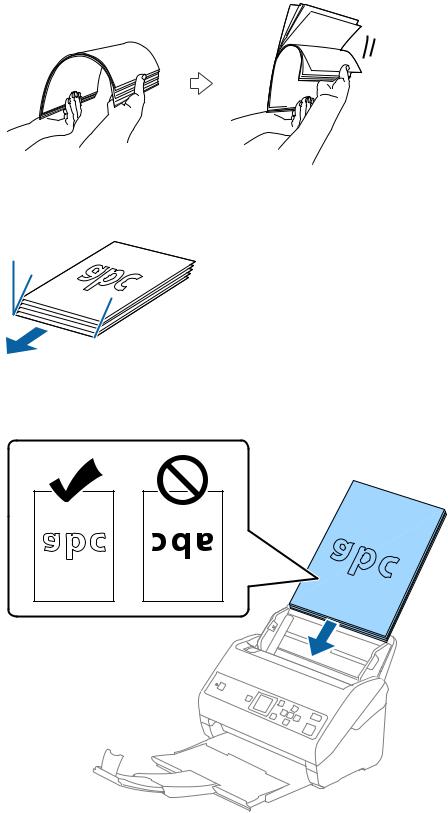
User's Guide
Specifications of Originals and Placing Originals
3.Fan the originals.
Hold both ends of the originals and fan them a few times.
4.Align the edges of the originals with the printed side facing down and slide the leading edge into a wedge shape.
5.Load the originals into the input tray facing down with the top edge facing into the ADF. Slide the originals into the ADF until they meet resistance.
29
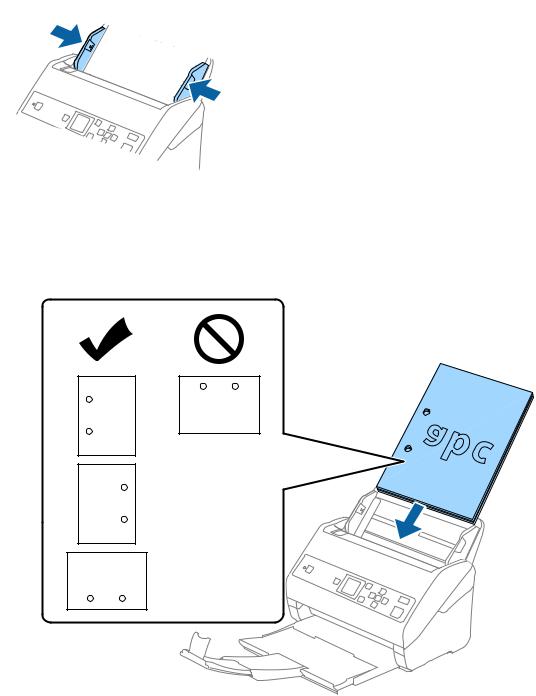
User's Guide
Specifications of Originals and Placing Originals
6.Slide the edge guides to fit the edge of the originals making sure there are no gaps between the originals and the edge guides. Otherwise, the originals may be fed skewed.
Note:
When scanning originals with punch holes such as loose leaf paper, load the originals with the holes facing to the side or facing down. There must not be any holes within a 30 mm (1.2 inches) strip at the center of the originals. However, there can be holes within 30 mm (1.2 inches) from the leading edge of the originals. Make sure that the edges of the punch holes do not have burrs or curls.
When scanning thin paper with crinkles that are causing paper jams or double feeds, you may be able to improve the situation by enabling Slow. To do this, select Settings > Scanner Settings > Slow on the control panel and set it to On to slow down the feeding speed.
30
